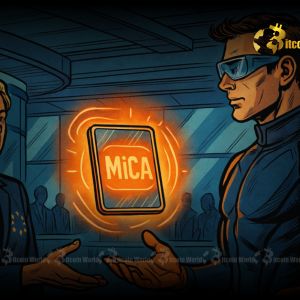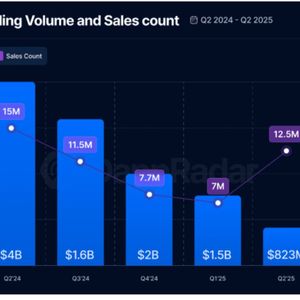Europe’s MiCA Unleashes New Era: 53 Crypto Entities Authorized, But Where Are Binance and Tether?
8 min read
BitcoinWorld Europe’s MiCA Unleashes New Era: 53 Crypto Entities Authorized, But Where Are Binance and Tether? The landscape of digital assets in Europe is undergoing a monumental transformation. If you’ve been following the cryptocurrency space, you’ve undoubtedly heard about the European Union’s groundbreaking Markets in Crypto-Assets Regulation, or MiCA. This isn’t just another piece of legislation; it’s a game-changer, setting a global precedent for comprehensive crypto oversight. And now, the first wave of authorized entities under this stringent MiCA regulation has been revealed, marking a pivotal moment for the industry. Understanding the Groundbreaking MiCA Regulation So, what exactly is MiCA, and why is it such a big deal? Launched with the aim of fostering innovation while protecting consumers and ensuring market integrity, MiCA is the EU’s holistic framework for regulating crypto assets and related services. It’s designed to bring clarity and legal certainty to a previously fragmented and often unregulated market across the 27 member states. Before MiCA, crypto businesses had to navigate a patchwork of national rules, leading to inefficiencies and regulatory arbitrage. MiCA seeks to harmonize these rules, creating a single market for crypto services. The regulation covers a wide array of crypto assets, categorizing them and applying specific rules to each. It distinguishes between: Crypto-Asset Service Providers (CASPs): Entities offering services like exchange, custody, transfer, or advisory related to crypto assets. Asset-Referenced Tokens (ARTs): Stablecoins that aim to maintain a stable value by referencing multiple fiat currencies, commodities, or other crypto assets. E-Money Tokens (EMTs): Stablecoins that aim to maintain a stable value by referencing a single fiat currency, similar to traditional e-money. The phased implementation of MiCA means that rules for stablecoins (ARTs and EMTs) came into effect earlier, on June 30, 2024, while the broader rules for CASPs will apply from December 30, 2024. This staggered approach allows the industry and regulators to adapt more smoothly to the new requirements. A New Dawn: The First Wave of Authorized EU Crypto Entities The recent announcement by Patrick Hansen, Director of EU Strategy & Policy at Circle, on X, has sent ripples through the crypto community. A total of 53 entities have officially received authorization under MiCA, signaling a new era of regulated crypto operations within the EU. This isn’t just a number; it represents a significant step towards a more mature and trustworthy digital asset ecosystem. These authorizations are a testament to the rigorous due diligence and compliance efforts undertaken by these companies, and they set a high bar for others seeking to operate within the bloc. Who Are the Newly Authorized Crypto Service Providers? Among the 53 authorized entities, a significant portion comprises authorized crypto service providers , or CASPs. These are the companies that facilitate the buying, selling, trading, and holding of various crypto assets. Their authorization means they have met MiCA’s stringent requirements concerning operational resilience, consumer protection, governance, and anti-money laundering (AML) protocols. This provides a layer of security and trust for European consumers engaging with their platforms. Prominent names on this list include: Coinbase: A leading global crypto exchange, already known for its strong regulatory posture in various jurisdictions. Their inclusion signifies their commitment to operating within regulated frameworks. Kraken: Another major exchange that has been active in advocating for clear crypto regulations. Their authorization strengthens their position in the European market. OKX: A global exchange expanding its footprint, demonstrating its intent to comply with European standards. Robinhood: Known for its commission-free trading, Robinhood’s entry into the EU crypto market under MiCA authorization highlights the convergence of traditional finance and digital assets. These companies, by securing authorization, gain a significant competitive advantage. They can now offer their services across all EU member states with a single license, reducing operational complexities and fostering greater market access. For users, this means increased confidence in the platforms they use, knowing they are operating under a harmonized and robust regulatory framework. The Rise of Regulated Stablecoin Issuers MiCA places a particular emphasis on stablecoins, recognizing their potential for widespread adoption and the associated risks. Of the 53 authorized entities, 14 are specifically designated as stablecoin issuers , responsible for issuing 20 e-money tokens (EMTs). EMTs are crucial because they are backed by a single fiat currency (like the Euro or US Dollar) and are regulated similarly to traditional electronic money. This ensures that these digital assets maintain their peg and that consumer funds are protected. Key authorized EMT issuers include: Circle: The issuer of USDC, one of the largest stablecoins globally. Circle’s authorization for its Euro-backed stablecoin (EURC) is a major milestone, providing a regulated digital euro option for European users. This demonstrates MiCA’s success in attracting established players to operate within its framework. Crypto.com: Another major crypto platform that has diversified into stablecoin issuance, reflecting the broader industry trend towards regulated digital currencies. The authorization of these stablecoin issuers is critical for the stability and growth of the European digital economy. It provides a regulated on-ramp and off-ramp for fiat into the crypto ecosystem, potentially paving the way for broader adoption of digital payments and decentralized finance (DeFi) within a compliant environment. The Elephant in the Room: Where Are Binance and Tether MiCA Authorizations? While the list of authorized entities features many prominent names, the absence of two giants, Binance and Tether, has certainly caught the attention of the crypto world. Binance, the world’s largest crypto exchange by trading volume, and Tether, the issuer of USDT, the largest stablecoin by market capitalization, are conspicuously missing from the initial MiCA authorization lists. This raises important questions and sparks considerable discussion within the industry. Why the Absence? Speculating on Binance and Tether’s MiCA Journey There could be several reasons why Binance and Tether MiCA authorizations are not yet finalized. It’s important to note that absence from this initial list does not necessarily mean rejection or non-compliance; it could simply indicate that their application processes are ongoing, or their strategic approaches differ. Application Status: Both Binance and Tether are massive, complex global operations. Their applications for MiCA authorization would be incredibly detailed and extensive, requiring significant time for review by European regulators. It’s plausible that their applications are still under review, given the sheer scale of their operations and the volume of data required. Jurisdictional Challenges: Binance operates through various regional entities. Its global structure and the regulatory scrutiny it has faced in other jurisdictions (e.g., in the US, where it has faced legal challenges) might necessitate a more cautious and lengthy review process by EU authorities. Similarly, Tether’s operational structure and the history of its reserves have been subjects of intense scrutiny globally, which could impact the speed of its MiCA authorization. Business Model Alignment: MiCA has very specific requirements for different types of crypto assets and services. It’s possible that certain aspects of Binance’s diverse service offerings or Tether’s reserve management practices require adjustments to fully align with MiCA’s strict standards. For instance, MiCA imposes capital requirements and governance rules that might necessitate significant operational overhauls for some entities. Strategic Decisions: It’s also conceivable that Binance or Tether are strategically choosing to pursue authorization through specific national entities or are prioritizing other markets first. They might be waiting to observe the initial implementation phase before committing fully, or they could be planning to restructure certain aspects of their European operations to better fit the MiCA framework. Focus on Specific Entities: Binance, for example, might be pursuing authorization for specific EU-based subsidiaries rather than its entire global operation, which could lead to a staggered appearance on these lists. Ultimately, the EU’s approach under MiCA is to ensure robust regulatory oversight. Companies that have faced past regulatory challenges or operate with complex global structures may naturally experience longer review periods. The EU is prioritizing the integrity and stability of its financial markets, and large, influential players like Binance and Tether will be subject to the highest level of scrutiny. Implications for the European Crypto Market and Beyond The authorization of 53 EU crypto entities under MiCA is a monumental step with far-reaching implications, not just for Europe but for the global crypto landscape. For Consumers and Businesses in Europe For consumers, MiCA brings unprecedented levels of protection. Regulated entities must adhere to strict rules on transparency, investor disclosure, complaint handling, and operational security. This means less risk of fraud, better protection of assets, and clearer information about the products and services they are using. For businesses, while compliance can be burdensome and costly, the benefits of regulatory clarity and a unified market are immense. A single license allows them to passport their services across all 27 EU member states, unlocking a massive market without needing to navigate disparate national regulations. This clarity also fosters innovation. While some argue that regulation stifles innovation, a well-defined framework can actually encourage it by providing a stable and predictable environment for development. Businesses can build with confidence, knowing the rules of the game, and institutional investors, who typically shy away from unregulated markets, are more likely to enter the European crypto space. Global Ripple Effects MiCA is widely seen as a benchmark for crypto regulation worldwide. Jurisdictions like the UK, the US, and various Asian countries are closely observing its implementation. The success or challenges faced by MiCA could influence how other major economies approach their own crypto regulatory frameworks. It sets a precedent for how a large economic bloc can integrate digital assets into its financial system, balancing innovation with consumer protection and financial stability. The absence of Binance and Tether from the initial list also sends a clear message: no entity, regardless of its size or market dominance, is above the regulatory framework. This emphasizes the EU’s commitment to creating a level playing field and ensuring that all participants adhere to the same high standards. The Road Ahead: Challenges and Opportunities While the initial authorizations are a significant achievement, the journey of MiCA is far from over. Challenges remain, including the ongoing need for clear guidance on specific aspects of the regulation, the capacity of national regulators to oversee a rapidly evolving industry, and the need for continuous adaptation as new technologies emerge. However, the opportunities are even greater. MiCA has the potential to position Europe as a global leader in regulated digital finance, attracting investment and talent to the region. The coming months will likely see more entities gain authorization as their applications are processed and as the December 2024 deadline for CASPs approaches. The evolving list will be a key indicator of the health and maturity of the European crypto market. The inclusion of major players and the robust regulatory framework will undoubtedly build trust and drive further adoption of crypto assets in a secure and compliant manner. The initial wave of MiCA authorizations marks a pivotal moment for the European crypto landscape. With 53 entities now officially sanctioned, including key CASPs like Coinbase and prominent stablecoin issuers such as Circle, the EU is cementing its position as a frontrunner in regulated digital assets. While the absence of giants like Binance and Tether from this initial list sparks curiosity, it underscores MiCA’s rigorous standards and the EU’s unwavering commitment to market integrity and consumer protection. This new era promises greater transparency, security, and stability, paving the way for mainstream adoption and fostering innovation within a clear regulatory framework. The journey has just begun, and the eyes of the global crypto community will remain firmly fixed on Europe’s evolving digital asset future. To learn more about the latest crypto market trends, explore our article on key developments shaping the European digital asset landscape. This post Europe’s MiCA Unleashes New Era: 53 Crypto Entities Authorized, But Where Are Binance and Tether? first appeared on BitcoinWorld and is written by Editorial Team

Source: Bitcoin World



